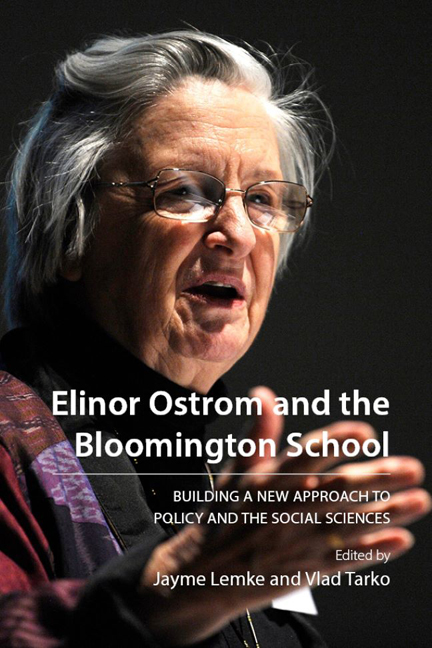Book contents
- Frontmatter
- Contents
- Acknowledgements
- Contributors
- 1 Introduction: the Bloomington school in context
- 2 Public choice theory: reuniting Virginia and Bloomington
- 3 New institutional economics: building from shared foundations
- 4 Elinor Ostrom as behavioral economist
- 5 New economic sociology and the Ostroms: a combined approach
- 6 Foundations of social order: the Ostroms and John Searle
- 7 Environmental policy from a self-governance perspective
- 8 Learning from the socialist calculation debate: is efficiency in public economics possible?
- 9 Public administration from “intellectual crisis” to contemporary “governance theory”
- 10 Rethinking federalism: social order through evolution or design?
- References
- Index
3 - New institutional economics: building from shared foundations
Published online by Cambridge University Press: 21 December 2023
- Frontmatter
- Contents
- Acknowledgements
- Contributors
- 1 Introduction: the Bloomington school in context
- 2 Public choice theory: reuniting Virginia and Bloomington
- 3 New institutional economics: building from shared foundations
- 4 Elinor Ostrom as behavioral economist
- 5 New economic sociology and the Ostroms: a combined approach
- 6 Foundations of social order: the Ostroms and John Searle
- 7 Environmental policy from a self-governance perspective
- 8 Learning from the socialist calculation debate: is efficiency in public economics possible?
- 9 Public administration from “intellectual crisis” to contemporary “governance theory”
- 10 Rethinking federalism: social order through evolution or design?
- References
- Index
Summary
This chapter explores similarities, contrasts, and connections between the Bloomington school of institutional analysis established by Vincent and Elinor Ostrom and new institutional economics (NIE). Although NIE was not included among the three “schools” or research traditions Mitchell (1988) identified as closely related but distinct approaches to the study of political economy active at that time, new institutional economics can also claim a common origin in the mid-twentieth century public choice movement, in which scholars from various disciplines brought concepts and methods from economics to bear on explicitly political subjects (Mitchell 1999; Aligica & Boettke 2009). As shown in this chapter, these two traditions of research have since gone in quite different directions.
In a nutshell, NIE and the Bloomington school offer complementary perspectives on the origins and sustainability of institutions, political economy, and social order. NIE sees the institutional order as primarily constituted in a network of organizations, and focuses on the principal–agent problem within formal organizations as the key difficulty in building a stable social order. By contrast, the Bloomington school sees the institutional order as a network of action arenas in which political, economic, and social actors work together to realize shared interests while acknowledging that each will nonetheless continue to also pursue self-interested goals. For those working in the Bloomington tradition, the key problem becomes reducing the frequency of free-riding or other behaviors that undermine trust within and across social groups.
This chapter examines a series of similarities and differences between NIE and the Bloomington school in their understanding of basic concepts and their tendency to rely on different, but related, methods of analysis. After this introductory section, I highlight their shared foundations in the basic tenets of methodological individualism and bounded rationality. The following section details how scholars working in these traditions interpret core concepts of institutions, organizations, and property rights in subtly different ways. I then show how these differences underlie more dramatic contrasts in their approach to broader issues of social order. The final section concludes by suggesting ways scholars from these two research traditions might combine their respective strengths to improve our collective understanding of important aspects of political, economic, and social order.
- Type
- Chapter
- Information
- Elinor Ostrom and the Bloomington SchoolBuilding a New Approach to Policy and the Social Sciences, pp. 25 - 46Publisher: Agenda PublishingPrint publication year: 2021



